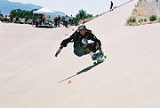
Slalom skateboarding
Encyclopedia
Slalom skateboarding is a form of downhill skateboard racing that first appeared in the 60's and 70's and has made a resurgence in popularity in the 2000s. Slalom racers skate down a course marked usually by plastic cones. The racer tries to get through the course with the fastest time, while knocking down the fewest number of cones. Each cone typically carries a penalty of a fraction of a second which is added to the skaters time.
The most unique thing about slalom skateboard rules is that skaters are penalized a certain amount of time for each cone that they hit during a race. This penalty time is added to the racers run time. If too many cones are hit during the run, the racer receives a DQ. A DQ is often penalized in head-to-head racing with a severe time penalty that is rarely made up in a the second heat of a head to head race.
Another group of rules known as "Grass Roots" rules may be used to simplify the racing environment. In grass roots rules, racers are allowed to hit a certain maximum number of cones. Below the maximum (oftentimes 5 cones) there is no penalty, and above the maximum is a DQ.
In all types of head-to-head racing, race order is determined by a qualifying time which determines the brackets for head-to-head match ups.
Disciplines
Races can be done in dual format were the racing is a head-to-head match, or in a single lane format where the racer is only racing against the clock. There are five types of Slalom race formats; Super Giant Slalom, Giant Slalom, Hybrid Slalom (a.k.a Special Slalom), Tight Slalom, and Banked Slalom. The Super Giant Slalom, or SuperG, is characterized by fast speeds of 30-40 mph, very long distances between cones (up to 40-50 feet) and run times of around 1 minute. Giant Slalom is similar to SuperG but is typically smaller cone distances, more cones, and is often time run in dual format. Hybrid or Special slalom is a combination of Giant Slalom cone spacings of 10-15' and tight cones spacings of 5-7' and is most often run head-to-head. Tight Slalom is characterized by very small cones spacings of 5'-7' and has the highest frequency of turns. Tight slalom skaters will pass through 3-4 cones per second. Banked slalom involves skating through a course on banked walls, such as in a skatepark, or in a drainage ditch. Banked slalom is similar to other forms of slalom except that it is almost never head-to-head and the course weaves through a non-level obstacle course, not a street where the other forms of slalom are done.Rules
The rules used for slalom skateboarding are currently maintained by the International Slalom Skateboard Association and can be found on [slalomskateboarder.com]The most unique thing about slalom skateboard rules is that skaters are penalized a certain amount of time for each cone that they hit during a race. This penalty time is added to the racers run time. If too many cones are hit during the run, the racer receives a DQ. A DQ is often penalized in head-to-head racing with a severe time penalty that is rarely made up in a the second heat of a head to head race.
Another group of rules known as "Grass Roots" rules may be used to simplify the racing environment. In grass roots rules, racers are allowed to hit a certain maximum number of cones. Below the maximum (oftentimes 5 cones) there is no penalty, and above the maximum is a DQ.
In all types of head-to-head racing, race order is determined by a qualifying time which determines the brackets for head-to-head match ups.

